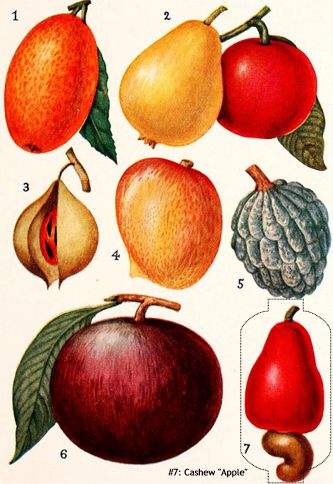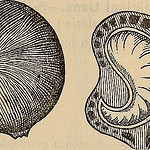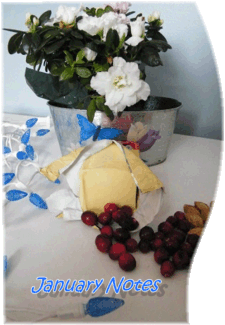CLICK: Color Control Color Choice

Once upon a time, cashew nuts were two dollars per pound. When I was young, I lived on cashew nuts, brown rice, fresh fruit and vegetables, yoghurt and sunflower seeds. Our average food cost was five dollars per week. We lived in a City Co-operative community, and worked for each other maintaining a food co-op.
Of course, our food came from a wholesale source and was three times less than from a market. But the cost of food, like everything else, was way less than it is today.
Today, cashew nuts are from nine to thirteen dollars per pound. Our household only enjoys the wonderful, creamy , soft nuts during festivals when we permit ourselves some luxuries.
To the left, in the botanical illustration, number 7 illustrates the pod or casing of the Cashew nut. This image demonstrates why the nut case is called an "apple". The image is made available from:
Internet Archive Book Images, on Flickr.com
As I researched the cashew nut and apple on the net, I found that the harvest is made difficult by a property of the apple and casing. It blisters the skin, causing contact dermatitis, and is considered the worst cause of dermatitis. The cashew is from the family Anicardiaceae.
To quote the research of the BoDD Botanical Database:
"The skin reaction occurs following sensitisation to various alkyl catechols, phenols, quinols, and resorcinols. At high concentrations, these compounds are also primary irritants."

Anacardium
occidentale L:
This cashew tree is a native of Brazil, and is harvested principally for nuts, but also produces an oil, a gum, and timber, called acajou, used in boat-building. Other names for the tree are Cashew-Nut Tree, jambu Gajus, Jambu Golok, Keterek,Marãnón , Jocote Marãnón.
Psst- click the illustration to the right, to link to an early botanical description of substance from the Cashew kernel:
A botanical description indicates that Cashew has been used, traditionally for skin treatment: Pharmacopaeia circa 1884:
"..used for hand lotion and warts: Glycerite of starch is also used per se as a soothing application tochafed surfaces, chapped hands, etc. Anacardium Occidentale. Occidental (oe Teue) Anacaedium. Anacardii Occidentalis Fructus— Cashew Nut. Origin.—Anacardium occidentale, Linne (Anacardiacece).Habitat.—Tropical America ; naturalized in Africa and the EastIndies. Part used.—The fruit.
Description and Constituents.—See Figs. 34 and 35.
A kidney- UNITED STATES PHARMACOPOEIA. 141"
The following is also fromBoDD, since the notation on cashew fruit, called an apple from which the nut grows at the end, is annotated as the work of Morton in 1961.
" The yellow or red cashew apple (technically a swollen peduncle) contains a juice that is astringent until the fruit is ripe, when it is acid but edible. The apple is the receptacle of the true fruit - the cashew nut. This nut is lightly attached to the apex of the apple, and attains its full size before the receptacle enlarges to form the apple. The apple is thus a false fruit. Between the smooth outer shell and the inner shell of the nut is a fibrous pulp containing a sticky brown oil - cashew nut shell liquid. This is caustic and sensitising. The kidney shaped kernel is the cashew nut of commerce and is innocuous unless contaminated with the shell oil, in which case it will appear blackened. As with other nuts, the kernel contains a fixed oil resembling almond oil (Prunus amygdalus Batsch, fam. Rosaceae). This is termed cashew oil or anacardic oil. Ambiguity may arise between the the use of the terms cashew oil and cashew nut shell liquid"
(Morton 1961).
The nuts have to be roasted in their shells in order to extract them safely.There is little difficulty for the nut consumer, but the oil from the pod is extracted separately to create a chemical which blisters a layer of skin. This is used in a cosmetic process.
The nut shell oil can be found in use as folk medicine ( a rubefascient) in brake liners,a preservative for fishing lines,and an insect repellant in book liners. A dark pigment from the shell and apple is used as a permanent ink marker, and also in hair dye. The oil is also used as a varnish, but should be used with educated concern as to its nature.
I have never thought of the cashew nut casing itself. It is a beautiful fruit to behold. An excellent source of an image for the actual fruit is fromThe University of Hawaii Botanical Department. Go to Faculty: Carr and then anacardi.htm, or "cashew".
A most interesting spinoff of this fruit is the sculpture to be found on a site from France,"Le Laboratoire de Phanerogamie du Museum" (Find Collections, go to Carporama)
There is a great deal of info in the links listed above as BoDD Botanical. Suggested reading is both BoDD and an interest link on ecologization, "Ecologization for Poverty"

